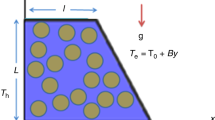Abstract
A parameter perturbation for the unsteady-state heat-transfer characteristics of honeycomb regenerator is presented. It is limited to the cases where the storage matrix has a small wall thickness so that no temperature variation in the matrix perpendicular to the flow direction is considered. Starting from a two-phase transient thermal model for the gas and storage matrix, an approximate solution for regenerator heat transfer process is derived using i.he multiplescale method for the limiting case where the longitudinal heat conduction of solid matrix is far less than the convective heat transfer between the gas and the solid. The regenerator temperature profiles are expressed as Taylor series of the coefficient of solid heat conduction item in the model. The analytical validity is shown by comparing the perturbation solution with the experiment and the numerical solution. The results show that it is possible for the perturbation to improve the effectiveness and economics of thermal research on regenerators.
Similar content being viewed by others
References
Hiroshi T, Gupta A, Hasegawa T, et al. High Temperature Air Combustion From Energy Conservation to Pollution Reduction [M]. New York. USA: CRC Press. 2003.
Chun X T, Jian D T. Application and Development of Honeycomb Regenerative Combustion System [J]. Industrial Heating, 1998, 35(3): 26–35 (in Japanese).
LI Wei, QI Hai-ying, YOU Chang-fu, et al. Numeric Research on Heat Transfer in Honeycomb Regenerator [J]. Journal of Engineering Thermophysics, 2001, 22(5): 657–660 (in Chinese).
LI Jin, FU Wei-biao, HOU Ling-yun. Numerical Analysis for a Regenerative and Generative Hydrogen Unit [J]. Journal of Combustion Science and Technology, 2003, 9(3): 261–266 (in Chinese).
Nabil R, Wlodzimierz B. Thermal Performance Analysis on a Two Composite Material Honeycomb Heat Regenerators Used for HiTAC Burners [J]. Applied Thermal Engineering, 2005, 25(17–18): 2966–2982.
Zarrinehkafsh M T, Sadrameli S M. Simulation of Fixed Bed Regenerative Heat Exchangers for Flue Gas Heat Recovery [J]. Applied Thermal Engineering, 2004, 24(2-3): 373–382.
Zheng C H, Clements B. The Thermal Performance Characteristics of Regenerators in HiTACG Furnaces [A]. Gaswärme-Institut e V Essen, eds. 6th International Symposium on High Temperature Air Combustion and Gasification [C]. Ruhrgebiet, Germany: Gas Wärme Institut, 2005. A9. 1–A9. 12.
Klein H, Eigenberger G. Approximate Solutions for Metallic Regenerative Heat Exchangers [J]. International Journal of Heal and Mass Transfer, 2001, 44(18): 3553–3563.
LI Mao-de, CHENG Hui-er. Theoretical Analysis of Heat Transfer of Ceramic Regenerator in High Temperature Air Combustion System [J]. Journal of Thermal Science and Technology, 2004, 3(3): 255–260 (in Chinese).
Author information
Authors and Affiliations
Corresponding author
Additional information
Foundation Item: Item Sponsored by High Technology Research and Development Program of China (2005AA001020, 2001AA514013)
Biography: AI Yuan-fang( 1968-). Male, Doctor, Associate Professor;
Rights and permissions
About this article
Cite this article
Ai, Yf., Mei, C., Huang, Gd. et al. Perturbation Solutions for Thermal Process of Honeycomb Regenerator. J. Iron Steel Res. Int. 14, 6–10 (2007). https://doi.org/10.1016/S1006-706X(07)60049-1
Revised:
Published:
Issue Date:
DOI: https://doi.org/10.1016/S1006-706X(07)60049-1




